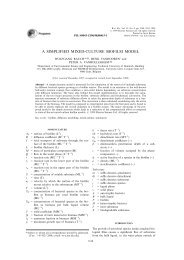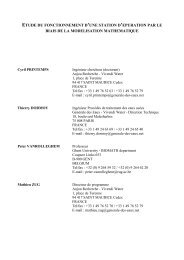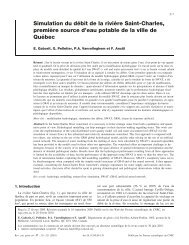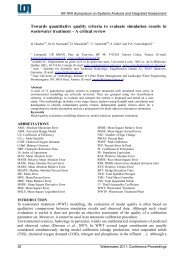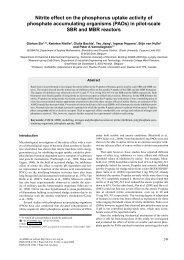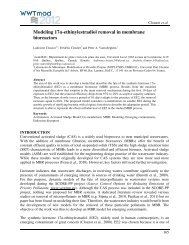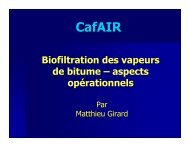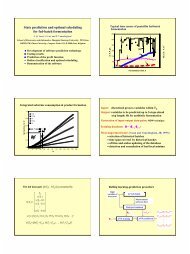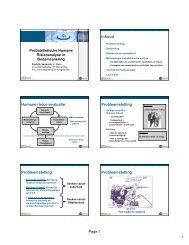Biological Phosphorus Removal Using SBR Technology :
Biological Phosphorus Removal Using SBR Technology :
Biological Phosphorus Removal Using SBR Technology :
Create successful ePaper yourself
Turn your PDF publications into a flip-book with our unique Google optimized e-Paper software.
According to Yamamoto-Ikemoto et al. (1991), deterioration of EBPR activity was linked with high sulphate<br />
reduction producing high concentration of sulphide. The high sulphide concentration induced growth of filamentous<br />
bacteria, i.e. Beggiatoa spp. Consequently, the longer the sulphate reduction activity, the higher the<br />
phosphate concentration observed in the effluent. Whereas sulphide was never observed in our system, except<br />
for the times when nitrogen bubbling was deliberately switched off, growth of filamentous bacteria was clearly<br />
observed. Fast uptake of sulphide by the microbial population is a possible explanation for the sulphide profile<br />
to be absent.<br />
Competition<br />
Denitrifying<br />
bacteria<br />
Sulphate reducing<br />
bacteria<br />
Competition<br />
HS -<br />
SO 4<br />
Poly-P accumulating<br />
bacteria<br />
Hindrance by strong<br />
sulphate reduction<br />
Filamentous sulphur<br />
bacteria<br />
Figure 2 Model of ecological interactions among denitrifying bacteria, PAOs, SRBs and filamentous sulphur<br />
bacteria in activated sludge (after Yamamoto-Ikemoto et al., 1994)<br />
CONCLUSIONS<br />
Simultaneous occurrence of anaerobic sulphate reduction and phosphorus release was possible, but proved to be<br />
a process vulnerable to fast deterioration of EBPR activity due to changed operating conditions. Growth of<br />
filamentous bacteria, with Beggiatoa spp. as dominant organism, was always observed concurrent with sulphate<br />
reduction, even at low levels. It is expected that the higher the sulphate reduction, the more dominant the<br />
growth of these filamentous bacteria will become, with fast deterioration of EBPR.<br />
It was observed that PAO activity was suppressed, but could very quickly restore its acetate uptake and overall<br />
P-removal capacity. Regrowth of PAOs allowed complete recovery of EBPR activity within 3 sludge ages.<br />
REFERENCES<br />
Arvin, E. and Kristensen, G.H. Exchange of organics, phosphate and cations between sludge and water in biological phosphorus and<br />
nitrogen removal processes. Wat. Sci. Tech., 17(11/12), 147-162 (1985)<br />
Barnard, J.L. <strong>Biological</strong> nutrient removal without the addition of chemicals. Wat. Res., 9, 485-490 (1975)<br />
Cech, J. S. and Hartman, P. Glucose induced breakdown of enhanced biological phosphate removal. Environ. Technol., 11, 651-656<br />
(1990)<br />
Cech, J. S. and Hartman, P. Competition between polyphosphate and polysaccharide accumulating bacteria in enhanced biological<br />
phosphate removal systems. Wat. Res., 27(7), 1219-1225 (1993)<br />
Comeau, Y., Oldham, W.K. and Hall, K.J. Dynamics of carbon reserves in biological dephosphation of wastewater. Proc. IAWPRC<br />
Int. Conf. on <strong>Biological</strong> Phosphate <strong>Removal</strong> from Wastewaters, Rome, Italy Adv. Water Pollut. Cont. (ed. Ramadori), 39-55 (1987)<br />
Eikelboom, D.H. Sulfur-storing bacteria and bulking of activated sludge. In Environmental technologies to treat sulfur pollution, principles<br />
and engineering, 449-466 (ed. Lens and Pol), 1 st Ed., IWA Publishing, London, UK (2000)<br />
Ekama, G.A. and Marais, G.v.R. Influence of wastewater characteristics on process design. In: Theory, design and operation of nutrient<br />
removal activated sludge processes., 3, 1-10 (Water Research Commission) Pretoria, South Africa (1984)<br />
Fuhs, G.W. and Chen, M. Microbiological basis of phosphate removal in the activated sludge process for treatment of wastewater.<br />
Microbiol. Ecol., 2(2), 119-138 (1975)<br />
Jeon, C.O. and Park, J.M. Enhanced biological phosphorus removal in a sequencing batch reactor supplied with glucose as a sole carbon<br />
source. Wat. Res., 34(7), 2160-2170 (2000)<br />
Malnou, D., Meganck, M., Faup, G.M. and du Rostu, M. <strong>Biological</strong> phosphorus removal: study of the main parameters. Wat. Sci.<br />
Tech., 16(10/11) (1984)<br />
Potgieter, D.J.J. and Evans, B.W. Biochemical changes associated with luxury phosphate uptake in a modified phoredox activated<br />
sludge system. Wat. Sci. Tech., 15(2/3), 105-116 (1983)<br />
Wanner, J. and Grau, P. Filamentous bulking in nutrient removal activated sludge systems. Wat. Sci. Tech., 21(4/5), 1-8 (1987)<br />
Yamamoto-Ikemoto, R., Komori, T. and Matsui, S. Filamentous bulking and hindrance of phosphate removal due to sulphate reduction<br />
in activated sludge. Wat. Sci. Tech., 23(Kyoto), 927-935 (1991)<br />
Yamamoto-Ikemoto, R., Matsui, S. and Komori, T. Ecological interactions among denitrification, poly-P accumulation, sulfate reduction,<br />
and filamentous sulfur bacteria in activated sludge. Wat. Sci. Tech., 30, 201-210 (1994)<br />
Yamamoto-Ikemoto, R., Matsui, S., Komori, T. and Bosque-Hamilton, E.J. Symbiosis and competition among sulfate reduction, filamentous<br />
sulfur, denitrification, and poly-P accumulation bacteria in the anaerobic-oxic activated sludge of a municipal plant18th<br />
IAWQ Biennial International Conference, Singapore (1996)



